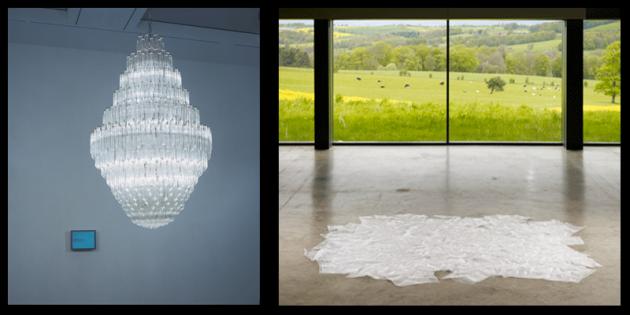The exceptional environment and light qualities of Yorkshire Sculpture Park’s 18th-century Chapel, is the inspiration for a new exhibition. Transparency shares significant works from the Arts Council Collection that explore the condition of transparency, and features pieces by artists including Yelena Popova, Mark Titchner, Rachel Whiteread and Cerith Wyn Evans.
Comprising of fifteen sculptures, installations and films, made between 1978 and 2014, Transparency considers how artists have investigated subjects such as truth to material, the everyday or ordinary, and material and psychological transparency. Produced during a period when the demand for truth and openness from politicians, corporations and other institutions is especially evident, the exhibition reflects a shift in British culture.
The notion of transparency is extended by considering the multiple meanings of the word: from the property of transmitting light, being diaphanous and having clarity, to being free from pretence or deceit, of being readily understood, and characterised by visibility or accessibility of information.
The exhibition includes three works by Yelena Popova, whose practice is informed by her upbringing in a secret settlement – an unnamed place – dedicated to nuclear research. Unnamed (2011), the artist’s first film, made as part of her MA at the Royal College of Art, recounts the story of the ‘secret town’ she grew up in and its part in both the development of the Soviet Union’s first atomic bomb and a major nuclear disaster in 1957. Two paintings from Popova’s Evaporating series (2014) are beautiful ‘transparent images’, delicate and fragile, which seem to recede into the raw fabric of their construction and are described by the artist as ‘the counterpoint to our media-saturated lives’.
Leading contemporary artist Cerith Wyn Evans makes sculpture, installations, photographs, film and text works that consider how ideas are shared through form. The installation “Diary: How to Improve the world (you will only make matters worse) continued 1968 (revised)” from ‘M’ writings ’67-’72 by John Cage(2003), features a captivating and imposing chandelier at eye level and pays homage to a work by John Cage. The chandelier flashes on and off to convey a Morse code translation of Cage’s writings, which is then converted back into text on a nearby monitor.
St Mary’s No.1 (1978) by the important British sculptor Garth Evans is part of a series begun by the artist in 1969–70 in which he sought to make something that could be defined as sculpture yet was not an ‘object’. Inspired by a pool of water in the artist’s chapel studio, the delicate, almost weightless piece accrues greater resonance in the context of YSP’s historic chapel.
Transparency is the second in a series of exhibitions curated from the Arts Council Collection as part of the National Partners Programme marking the Collection’s 70th anniversary. The first exhibition, At Home, is presented in YSP’s newly refurbished Bothy Gallery until 3 July 2016. Both exhibitions offer a connection to Roger Hiorns’ installation Seizure (2008/2013), an extraordinary crystal-covered flat first created in a condemned property in Elephant and Castle and removed and preserved by the Arts Council Collection. Seizure is on long-term loan to YSP where it is presented within an award-winning concrete structure, commissioned from Adam Khan Architects, near the Bothy Garden.
Transparency : A National Partners Programme exhibition from the Arts Council Collection YSP 25 June–4 September 2016

